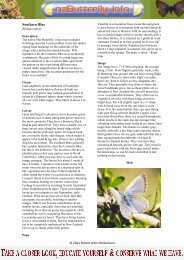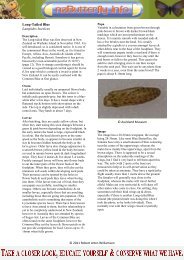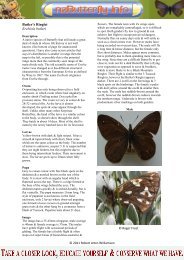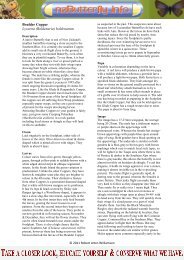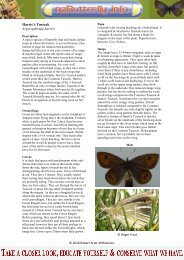Black Mountain Ringlet Percnodaimon merula - NZ Butterfly Info
Black Mountain Ringlet Percnodaimon merula - NZ Butterfly Info
Black Mountain Ringlet Percnodaimon merula - NZ Butterfly Info
Create successful ePaper yourself
Turn your PDF publications into a flip-book with our unique Google optimized e-Paper software.
<strong>Black</strong> <strong>Mountain</strong> <strong>Ringlet</strong><strong>Percnodaimon</strong> <strong>merula</strong>DescriptionA native species of <strong>Butterfly</strong> that still needs fartherstudy & whose life history is not well known. (Seebottom of page for unanswered questions). It was aspecies that was considered to live about a year, butsince the larvae can take 2-3 summers to grow tofull size, this would mean it is a very long-lived<strong>Butterfly</strong>, certainly New Zealand's longest lived<strong>Butterfly</strong>. This is an adaption to the high altitudeenvironment it lives in where there are long winters& cool summers. Some people believe there are 2separate groups that live in opposite years as thereseems to be a good year followed by a poor year. Itwas originally named Erebia pluto after it'sEuropean namesake whose English name is theSooty <strong>Ringlet</strong>. There is only minor differencesbetween the two species, mainly the style ofpupation & the <strong>Black</strong> <strong>Mountain</strong> <strong>Ringlet</strong> doesn'thave any orange wing markings that are found onthe European species. It has some parasitism from aTachinid fly in the Plagiomyia genus as a larva & acouple of mites that live on the imagos, which theyprobably pick up from other insects whilesheltering.OvumAre deposited singularly on the lower surface ofsunny rocks that sometimes are not that near-by, sothey can take advantage of the suns heat & developquicker. The only New Zealand species that doesthis. Initially blue, which get mottled brownpatches after a couple of days to blend in with thesurrounding rocks. 2 days before hatching thismottling is lost as the dark brown head becomesvisible. It is barrel-shaped with 32 vertical ribs.They hatch in about 12 days in lowland summerconditions, but this will be longer in the highmountain altitude. All but the base of the shell iseaten by the newly hatched larva for its first meal.LarvaeColour varies from a dull blue-grey to a strawbrown.The straw-brown variation could beconfused with the Butler's <strong>Ringlet</strong>, but they aregenerally quite different. It has short black setae &short bifid projections on the tail end. They have 5instars each taking at least 30 days in favourablesummer temperatures, however this can be up to 8months if over-wintering. They get to the end of the1st instar or beginning of the 2nd by winter.Because they have slow growth, they can remain aslarvae up to 2 years (over 3 summers). It can enterwinter hibernation (probably diapause) at anyinstar. This long larval stage means that larvae canbe found all year round in most instars. They areslow in all aspects of life & are generally nightfeeders, but will also feed on misty days on the tipsof Tussock blades. They appear to spend very littletime actively eating choosing to spend most of theirtime hiding in a near-by sheltered spot near thebase of the foodplant. Their hiding behaviourmeant that a larvae wasn't seen until 1968. Thisshould save them from being eaten from predatorslike birds as they are easy to spot when they areeating the tips of Tussock. Grows up to 25mmwhen fully grown.PupaBlue-grey with brownish markings that match thestone until a few days before emerging when thedark body & wings start to show through. They areabout 16mm in length. They suspend themselves bya large cremaster & hang almost horizontally undera stone, this lets them take advantage of the heatstored in the stone. They have being recorded up to1 metre from the nearest foodplant. Pupation issuspected to be 2-3 weeks.ImagoThe imago has a 39-54mm wingspan. They arevelvety black with a paler underside, some have agreyish band on the underside. Has between 3 & 7variable size ocelli which are grouped in two rowson the forewing & 3 faint ones on the hindwing.There is a reported trend of less ocelli in southernranges. Generally has lighter brownish scalesaround the ocelli in the north, but this becomesdarker in the south of its range. Generally largerfrom the west of the main divide, with the largestbeing from the Fiordland area. Sexual dimorphismis non-existent in colouration, but is evident in sizeas females are generally larger then males. Unlikemost Satyrine Butterflies, they occur on the wing inequal numbers of both genders. They have a thinkhairy body to maintain warmth. They fly only whenthe sun is shining close to the ground with a lazyflight that zigzags taking advantage of rising aircurrents over scree slopes by often gliding withthey wings in a shallow 'v' position. They can havestrong flight if needed. Like the Boulder Copper,they rarely alight on vegetation preferring stoneswarmed by the sun. Often seen aligning itself totake advantage of the sun due to the generally cooltemperatures in the montane environment. Theywill settle amongst rocks as soon as a dull period orcloud comes over. Since they are a difficult<strong>Butterfly</strong> to get close to, look out for a dark<strong>Butterfly</strong> that is flying over scree & boulders asopposed to vegetation, which is more likely to be aButler's <strong>Ringlet</strong>. However beware your not caughtout by a Red Admiral as the flash of red is notalways easy to spot. Peak numbers are observed inJanuary.© 2011 Robert Arter-Williamson
Dark VarietyHabitatA sub-alpine & alpine <strong>Butterfly</strong> that can be foundfrom 800 to 2,000 metres on scree slopes. It is lesscommon below 1200m & very occasionally straysto lower altitudes.Food PlantsOnly recorded on Blue Tussock Grass (Poacolensoi) but it's suspected other related Tussockgrasses are also consumed.StatusRare Most of the alpine areas of the Southern Alpsabove 800m.DistributionLight VarietyPhenologyCopyrightAll content belongs to Robert Arter-Williamsonand www.nzbutterfly.info.Factsheet Design lay out by Stuart Desjardins.© 2011 Robert Arter-Williamson



